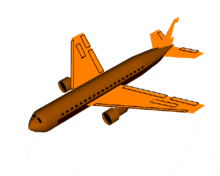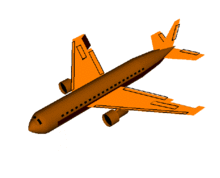Flight
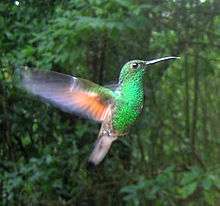
_arrives_London_Heathrow_11Apr2015_arp.jpg)
Flight is the process by which an object moves, through an atmosphere (the air in the case of earth) or beyond it (as in the case of spaceflight) without direct support from any surface. This can be achieved by generating aerodynamic lift, propulsive thrust, aerostatically using buoyancy, or by ballistic movement.
Many things fly, from natural aviators such as birds, bats and insects to human inventions such as missiles, aircraft such as airplanes, helicopters and balloons, to rockets such as spacecraft.
The engineering aspects of flight are studied in aerospace engineering which is subdivided into aeronautics, the study of vehicles that travel through the air, and astronautics, the study of vehicles that travel through space, and in ballistics, the study of the flight of projectiles.
Types of flight
Buoyant flight

Humans have managed to construct lighter than air vehicles that raise off the ground and fly, due to their buoyancy in air.
An aerostat is a system that remains aloft primarily through the use of buoyancy to give an aircraft the same overall density as air. Aerostats include free balloons, airships, and moored balloons. An aerostat's main structural component is its envelope, a lightweight skin containing a lifting gas[1][2] to provide buoyancy, to which other components are attached.
Aerostats are so named because they use "aerostatic" lift, a buoyant force that does not require lateral movement through the surrounding air mass. By contrast, aerodynes primarily use aerodynamic lift, which requires the lateral movement of at least some part of the aircraft through the surrounding air mass.
Aerodynamic flight
Unpowered flight versus powered flight
Some things that fly do not generate propulsive thrust through the air, for example, the flying squirrel. This is termed gliding. Some other things can exploit rising air to climb such as raptors (when gliding) and man-made sailplane gliders. This is termed soaring. However most other birds and all powered aircraft need a source of propulsion to climb. This is termed powered flight.
Animal flight
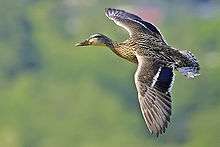

The only groups of living things that use powered flight are birds, insects, and bats, while many groups have evolved gliding. The extinct Pterosaurs, an order of reptiles contemporaneous with the dinosaurs, were also very successful flying animals. Each of these groups' wings evolved independently. The wings of the flying vertebrate groups are all based on the forelimbs, but differ significantly in structure; those of insects are hypothesized to be highly modified versions of structures that form gills in most other groups of arthropods.[3]
Bats are the only mammals capable of sustaining level flight.[4] However, there are several gliding mammals which are able to glide from tree to tree using fleshy membranes between their limbs; some can travel hundreds of meters in this way with very little loss in height. Flying frogs use greatly enlarged webbed feet for a similar purpose, and there are flying lizards which fold out their mobile ribs into a pair of flat gliding surfaces. "Flying" snakes also use mobile ribs to flatten their body into an aerodynamic shape, with a back and forth motion much the same as they use on the ground.
Flying fish can glide using enlarged wing-like fins, and have been observed soaring for hundreds of meters. It is thought that this ability was chosen by natural selection because it was an effective means of escape from underwater predators. The longest recorded flight of a flying fish was 45 seconds.[5]
Most birds fly (see bird flight), with some exceptions. The largest birds, the ostrich and the emu, are earthbound, as were the now-extinct dodos and the Phorusrhacids, which were the dominant predators of South America in the Cenozoic era. The non-flying penguins have wings adapted for use under water and use the same wing movements for swimming that most other birds use for flight. Most small flightless birds are native to small islands, and lead a lifestyle where flight would offer little advantage.
Among living animals that fly, the wandering albatross has the greatest wingspan, up to 3.5 meters (11 feet); the great bustard has the greatest weight, topping at 21 kilograms (46 pounds).[6]
Many species of insects also fly (See insect flight).
Mechanical
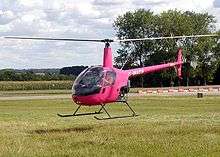
Mechanical flight is the use of a machine to fly. These machines include aircraft such as airplanes, gliders, helicopters, autogyros, airships, balloons, ornithopters as well as spacecraft. Gliders are capable of unpowered flight. Another form of mechanical flight is para-sailing where a parachute-like object is pulled by a boat. In an airplane, lift is created by the wings; the shape of the wings of the airplane are designed specially for the type of flight desired. There are different types of wings: tempered, semi-tempered, sweptback, rectangular and elliptical. An aircraft wing is sometimes called an airfoil, which is a device that creates lift when air flows across it.
Supersonic
Supersonic flight is flight faster than the speed of sound. Supersonic flight is associated with the formation of shock waves that form a sonic boom that can be heard from the ground,[7] and is frequently startling. This shockwave takes quite a lot of energy to create and this makes supersonic flight generally less efficient than subsonic flight at about 85% of the speed of sound.
Hypersonic
Hypersonic flight is very high speed flight where the heat generated by the compression of the air due to the motion through the air causes chemical changes to the air. Hypersonic flight is achieved by reentering spacecraft such as the Space Shuttle and Soyuz.

Ballistic
Atmospheric
Some things generate little or no lift and move only or mostly under the action of momentum, gravity, air drag and in some cases thrust. This is termed ballistic flight. Examples include balls, arrows, bullets, fireworks etc.
Spaceflight
Essentially an extreme form of ballistic flight, spaceflight is the use of space technology to achieve the flight of spacecraft into and through outer space. Examples include ballistic missiles, orbital spaceflight etc.
Spaceflight is used in space exploration, and also in commercial activities like space tourism and satellite telecommunications. Additional non-commercial uses of spaceflight include space observatories, reconnaissance satellites and other earth observation satellites.
A spaceflight typically begins with a rocket launch, which provides the initial thrust to overcome the force of gravity and propels the spacecraft from the surface of the Earth. Once in space, the motion of a spacecraft—both when unpropelled and when under propulsion—is covered by the area of study called astrodynamics. Some spacecraft remain in space indefinitely, some disintegrate during atmospheric reentry, and others reach a planetary or lunar surface for landing or impact.
History
Many human cultures have built devices that fly, from the earliest projectiles such as stones and spears,[8][9] the boomerang in Australia, the hot air Kongming lantern, and kites.
Aviation
George Cayley studied flight scientifically in the first half of the 19th century,[10][11][12] and in the second half of the 19th century Otto Lilienthal made over 200 gliding flights and was also one of the first to understand flight scientifically. His work was replicated and extended by the Wright brothers who made gliding flights and finally the first controlled and extended, manned powered flights.[13]
Spaceflight
Spaceflight, particularly human spaceflight became a reality in the 20th Century following theoretical and practical breakthroughs by Konstantin Tsiolkovsky and Robert H. Goddard. The first orbital spaceflight was in 1957[14] and Yuri Gagarin was carried aboard the first manned orbital spaceflight in 1961.[15]
Physics

There are different approaches to flight. If an object has a lower density than air, then it is buoyant and is able to float in the air without using energy. A heavier than air craft, known as an aerodyne, includes flighted animals and insects, fixed-wing aircraft and rotorcraft. Because the craft is heavier than air, it must generate lift to overcome its weight. The wind resistance caused by the craft moving through the air is called drag and is overcome by propulsive thrust except in the case of gliding.
Some vehicles also use thrust for flight, for example rockets and Harrier Jump Jets.
Finally, momentum dominates the flight of ballistic flying objects.
Forces
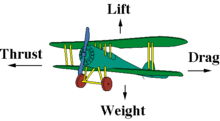
Forces relevant to flight are[16]
- Propulsive thrust: (except in gliders)
- Lift: created by the reaction to an airflow
- Drag: created by aerodynamic friction
- Weight: (created by gravity)
- Buoyancy: for lighter than air flight
These forces must be balanced for stable flight to occur.
Lift
In the context of an air flow relative to a flying body, the lift force is the component of the aerodynamic force that is perpendicular to the flow direction.[17] Aerodynamic lift results when the wing causes the surrounding air to be deflected - the air then causes a force on the wing in the opposite direction, in accordance with Newton's third law of motion.
Lift is commonly associated with the wing of an aircraft, although lift is also generated by rotors on rotorcraft (which are effectively rotating wings, performing the same function without requiring that the aircraft move forward through the air). While common meanings of the word "lift" suggest that lift opposes gravity, aerodynamic lift can be in any direction. When an aircraft is cruising for example, lift does oppose gravity, but lift occurs at an angle when climbing, descending or banking. On high-speed cars, the lift force is directed downwards (called "down-force") to keep the car stable on the road.
Lift can also occur in a different way if the air is not still, especially if there is an updraft due to heat ("thermals") or wind blowing along sloping terrain or other meteorological conditions. This form of lift permits soaring and is particularly important for gliding. It is used by birds and gliders to stay in the air for long periods with little effort.
Drag
For a solid object moving through a fluid, the drag is the component of the net aerodynamic or hydrodynamic force acting opposite to the direction of the movement.[18][19][20][21] Therefore, drag opposes the motion of the object, and in a powered vehicle it must be overcome by thrust. The process which creates lift also causes some drag. The lift-to-drag ratio will vary depending on the use for which the aircraft is intended.
Buoyancy
Air pressure acting up against an object in air is greater than the pressure above pushing down. The buoyancy, in both cases, is equal to the weight of fluid displaced - Archimedes' principle holds for air just as it does for water.
A cubic meter of air at ordinary atmospheric pressure and room temperature has a mass of about 1.2 kilograms, so its weight is about 12 newtons. Therefore, any 1-cubic-meter object in air is buoyed up with a force of 12 newtons. If the mass of the 1-cubic-meter object is greater than 1.2 kilograms (so that its weight is greater than 12 newtons), it falls to the ground when released. If an object of this size has a mass less than 1.2 kilograms, it rises in the air. Any object that has a mass that is less than the mass of an equal volume of air will rise in air - in other words, any object less dense than air will rise.
Lift-to-drag ratio

When lift is created by the motion of an object through the air, this deflects the air, and this is the source of lift. For sustained level flight, lift must be equal to weight.
However, this lift inevitably causes some drag also, and it turns out that the efficiency of lift creation can be associated with a lift-to-drag ratio for a vehicle; the lift-to-drag ratios are approximately constant over a wide range of speeds.
Lift-to-drag ratios can be determined by flight test, by calculation or by testing in a wind tunnel. Lift-to-drag ratios for practical aircraft vary from about 4:1 up to 60:1 or more. The lower ratios are generally for vehicles and birds with relatively short wings, and the higher ratios are for vehicles with very long wings, such as gliders. In general, long wings permit a large amount of air to be deflected and accelerated by a small amount, rather than a small amount of air by a large amount. Since energy is a square law on deflection speed, whereas lift is a linear relation, it takes less energy, and less lift-induced drag is created, with longer wings.
Thrust to weight ratio
Thrust-to-weight ratio is, as its name suggests, the ratio of instantaneous thrust to weight (where weight means weight at the Earth's standard acceleration ).[22] It is a dimensionless parameter characteristic of rockets and other jet engines and of vehicles propelled by such engines (typically space launch vehicles and jet aircraft).
If the thrust-to-weight ratio is greater than the local gravity strength (expressed in gs), then flight can occur without any forward motion or any aerodynamic lift being required.
If the thrust-to-weight ratio times the lift-to-drag ratio is greater than local gravity then takeoff using aerodynamic lift is possible.
Flight dynamics
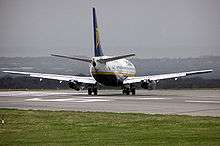
Flight dynamics is the science of air and space vehicle orientation and control in three dimensions. The three critical flight dynamics parameters are the angles of rotation in three dimensions about the vehicle's center of mass, known as pitch, roll and yaw (See Tait-Bryan rotations for an explanation).
The control of these dimensions can involve a horizontal stabilizer (i.e. "a tail"), ailerons and other movable aerodynamic devices which control angular stability i.e. flight attitude (which in turn affects altitude, heading). Wings are often angled slightly upwards- they have "positive dihedral angle" which gives inherent roll stabilization.
Energy efficiency
To create thrust so as to be able to gain height, and to push through the air to overcome the drag associated with lift all takes energy. Different objects and creatures capable of flight vary in the efficiency of their muscles, motors and how well this translates into forward thrust.
Propulsive efficiency determines how much energy vehicles generate from a unit of fuel.[23][24]
Range
The range that powered flight articles can achieve is ultimately limited by their drag, as well as how much energy they can store on board.
For powered aircraft the useful energy is determined by their fuel fraction- what percentage of the takeoff weight is fuel, as well as the specific energy of the fuel used.
Power-to-weight ratio
All animals and devices capable of sustained flight need relatively high power-to-weight ratios to be able to generate enough lift and/or thrust to achieve take off.
Takeoff and landing
Vehicles that can fly can have different ways to takeoff and land. Conventional aircraft accelerate along the ground until sufficient lift is generated for takeoff, and reverse the process for landing. Some aircraft can take off at low speed; this is called a short takeoff. Some aircraft such as helicopters and Harrier jump jets can take off and land vertically. Rockets also usually take off and land vertically, but some designs can land horizontally.
Guidance, navigation and control
Navigation
Navigation is the systems necessary to calculate current position (e.g. compass, GPS, LORAN, star tracker, inertial measurement unit, and altimeter).
In aircraft, successful air navigation involves piloting an aircraft from place to place without getting lost, breaking the laws applying to aircraft, or endangering the safety of those on board or on the ground.
The techniques used for navigation in the air will depend on whether the aircraft is flying under the visual flight rules (VFR) or the instrument flight rules (IFR). In the latter case, the pilot will navigate exclusively using instruments and radio navigation aids such as beacons, or as directed under radar control by air traffic control. In the VFR case, a pilot will largely navigate using dead reckoning combined with visual observations (known as pilotage), with reference to appropriate maps. This may be supplemented using radio navigation aids.
Guidance
A guidance system is a device or group of devices used in the navigation of a ship, aircraft, missile, rocket, satellite, or other moving object. Typically, guidance is responsible for the calculation of the vector (i.e., direction, velocity) toward an objective.
Control
A conventional fixed-wing aircraft flight control system consists of flight control surfaces, the respective cockpit controls, connecting linkages, and the necessary operating mechanisms to control an aircraft's direction in flight. Aircraft engine controls are also considered as flight controls as they change speed.
Traffic
In the case of aircraft, air traffic is controlled by air traffic control systems.
Collision avoidance is the process of controlling spacecraft to try to prevent collisions.
Flight safety
Air safety is a term encompassing the theory, investigation and categorization of flight failures, and the prevention of such failures through regulation, education and training. It can also be applied in the context of campaigns that inform the public as to the safety of air travel.
See also
| Wikimedia Commons has media related to Flight. |
References
- Notes
- ↑ Walker 2000, p. 541. Quote: the gas-bag of a balloon or airship.
- ↑ Coulson-Thomas 1976, p. 281. Quote: fabric enclosing gas-bags of airship.
- ↑ Averof, Michalis. "Evolutionary origin of insect wings from ancestral gills." Nature, Volume 385, Issue 385, February 1997, pp. 627–630.
- ↑ World Book Student. Chicago: World Book. Retrieved: April 29, 2011.
- ↑ "BBC article and video of flying fish." BBC, May 20, 2008. Retrieved: May 20, 2008.
- ↑ "Swan Identification." The Trumpeter Swan Society. Retrieved: January 3, 2012.
- ↑ Bern, Peter. "Concorde: You asked a pilot." BBC, October 23, 2003.
- ↑ "Archytas of Tar entum." Technology Museum of Thessaloniki, Macedonia, Greece/ Retrieved: May 6, 2012.
- ↑ "Ancient history." Automata. Retrieved:May 6, 2012.
- ↑ "Sir George Cayley". Flyingmachines.org. Retrieved 26 July 2009.
Sir George Cayley is one of the most important people in the history of aeronautics. Many consider him the first true scientific aerial investigator and the first person to understand the underlying principles and forces of flight.
- ↑ "The Pioneers: Aviation and Airmodelling". Retrieved 26 July 2009.
Sir George Cayley, is sometimes called the 'Father of Aviation'. A pioneer in his field, he is credited with the first major breakthrough in heavier-than-air flight. He was the first to identify the four aerodynamic forces of flight – weight, lift, drag, and thrust – and their relationship and also the first to build a successful human carrying glider.
- ↑ "U.S. Centennial of Flight Commission – Sir George Cayley.". Retrieved 10 September 2008.
Sir George Cayley, born in 1773, is sometimes called the Father of Aviation. A pioneer in his field, Cayley literally has two great spurts of aeronautical creativity, separated by years during which he did little with the subject. He was the first to identify the four aerodynamic forces of flight – weight, lift, drag, and thrust and their relationship. He was also the first to build a successful human-carrying glider. Cayley described many of the concepts and elements of the modern aeroplane and was the first to understand and explain in engineering terms the concepts of lift and thrust.
- ↑ "Orville Wright's Personal Letters on Aviation." Shapell Manuscript Foundation, (Chicago), 2012.
- ↑ http://history.nasa.gov/sputnik/sputorig.html
- ↑ "Gagarin anniversary." NASA. Retrieved: May 6, 2012.
- ↑ "Four forces on an aeroplane." NASA. Retrieved: January 3, 2012.
- ↑ "Definition of lift." NASA. Retrieved: May 6, 2012.
- ↑ French 1970, p. 210.
- ↑ "Basic flight physics." Berkeley University. Retrieved: May 6, 2012.
- ↑ "What is Drag?" NASA. Retrieved: May 6, 2012.
- ↑ "Motions of particles through fluids." lorien.ncl.ac. Retrieved: May 6, 2012.
- ↑ Sutton and Biblarz 2000, p. 442. Quote: "thrust-to-weight ratio F/W0 is a dimensionless parameter that is identical to the acceleration of the rocket propulsion system (expressed in multiples of g0) if it could fly by itself in a gravity free vacuum."
- ↑ ch10-3 "History." NASA. Retrieved: May 6, 2012.
- ↑ Honicke et al. 1968
- Bibliography
- Coulson-Thomas, Colin. The Oxford Illustrated Dictionary. Oxford, UK: Oxford University Press, 1976, First edition 1975, ISBN 978-0-19-861118-9.
- French, A. P. Newtonian Mechanics (The M.I.T. Introductory Physics Series) (1st ed.). New York: W. W. Norton & Company Inc., 1970.
- Honicke, K., R. Lindner, P. Anders, M. Krahl, H. Hadrich and K. Rohricht. Beschreibung der Konstruktion der Triebwerksanlagen. Berlin: Interflug, 1968.
- Sutton, George P. Oscar Biblarz. Rocket Propulsion Elements. New York: Wiley-Interscience, 2000 (7th edition). ISBN 978-0-471-32642-7.
- Walker, Peter. Chambers Dictionary of Science and Technology. Edinburgh: Chambers Harrap Publishers Ltd., 2000, First edition 1998. ISBN 978-0-550-14110-1.
External links
| Look up flight in Wiktionary, the free dictionary. |
| Wikivoyage has a travel guide for Flights. |
![]() Flight travel guide from Wikivoyage
Flight travel guide from Wikivoyage
- 'Birds in Flight and Aeroplanes' by Evolutionary Biologist and trained Engineer John Maynard-Smith Freeview video provided by the Vega Science Trust.


